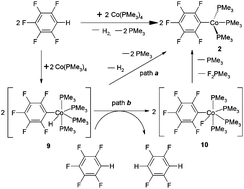Selective C–F/C–H bond activation of fluoroarenes by cobalt complex supported with phosphine ligands†
Abstract
The reactions of

* Corresponding authors
a
School of Chemistry and Chemical Engineering, Shandong University, Shanda Nanlu 27, 250100 Jinan, People's Republic of China
E-mail:
xli63@sdu.edu.cn
Fax: +86 531 88564464
b Department of Chemistry, Capital Normal University, 100037 Beijing, People's Republic of China
The reactions of

 Please wait while we load your content...
Something went wrong. Try again?
Please wait while we load your content...
Something went wrong. Try again?
J. Li, T. Zheng, H. Sun, W. Xu and X. Li, Dalton Trans., 2013, 42, 5740 DOI: 10.1039/C3DT33074E
To request permission to reproduce material from this article, please go to the Copyright Clearance Center request page.
If you are an author contributing to an RSC publication, you do not need to request permission provided correct acknowledgement is given.
If you are the author of this article, you do not need to request permission to reproduce figures and diagrams provided correct acknowledgement is given. If you want to reproduce the whole article in a third-party publication (excluding your thesis/dissertation for which permission is not required) please go to the Copyright Clearance Center request page.
Read more about how to correctly acknowledge RSC content.
 Fetching data from CrossRef.
Fetching data from CrossRef.
This may take some time to load.
Loading related content
